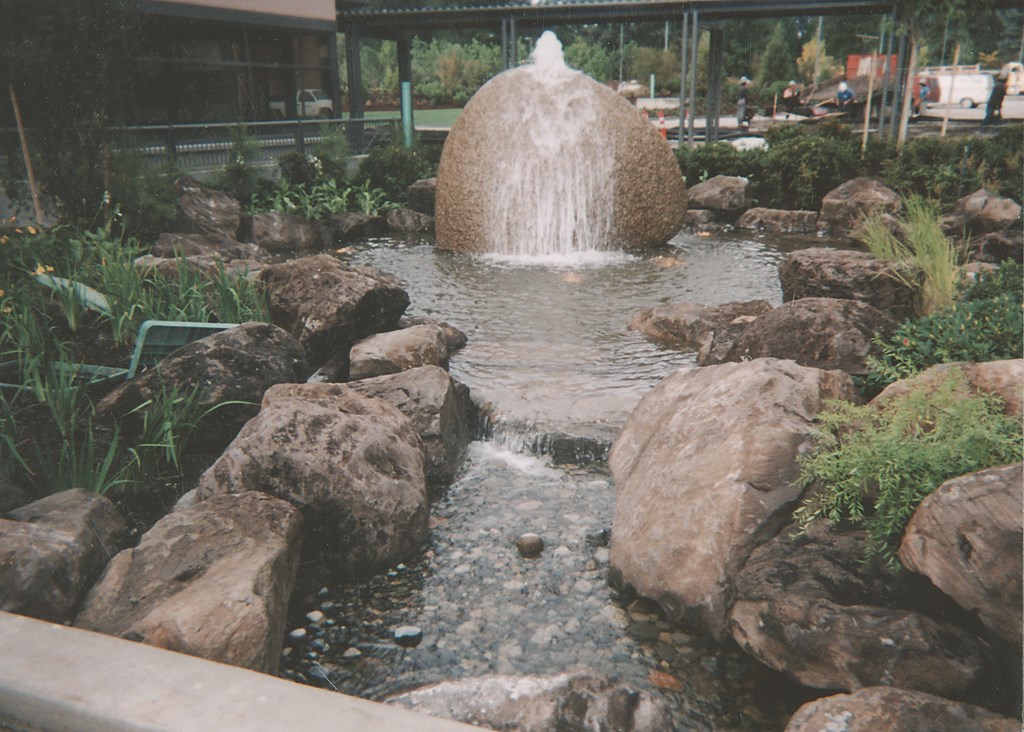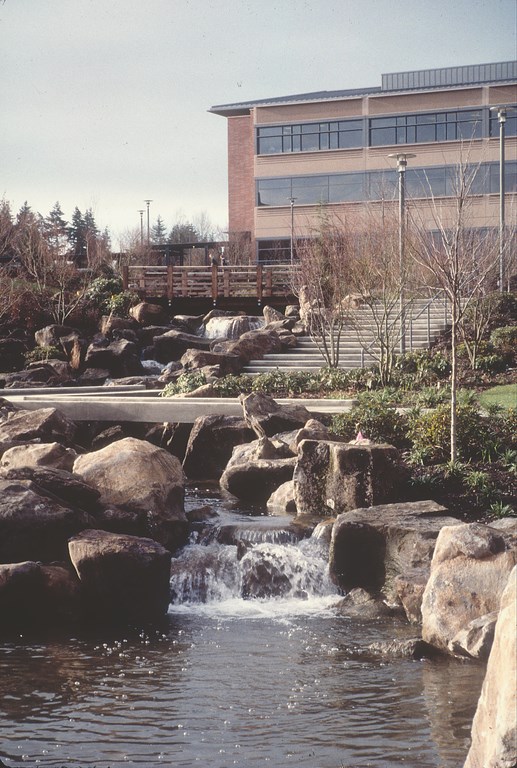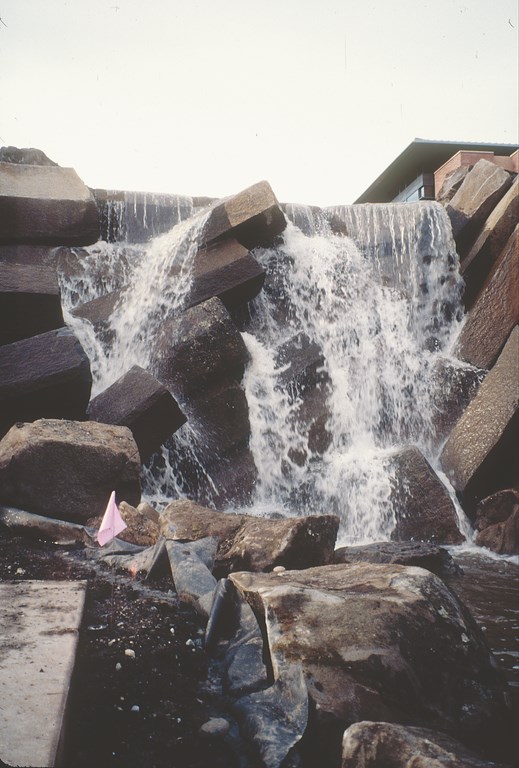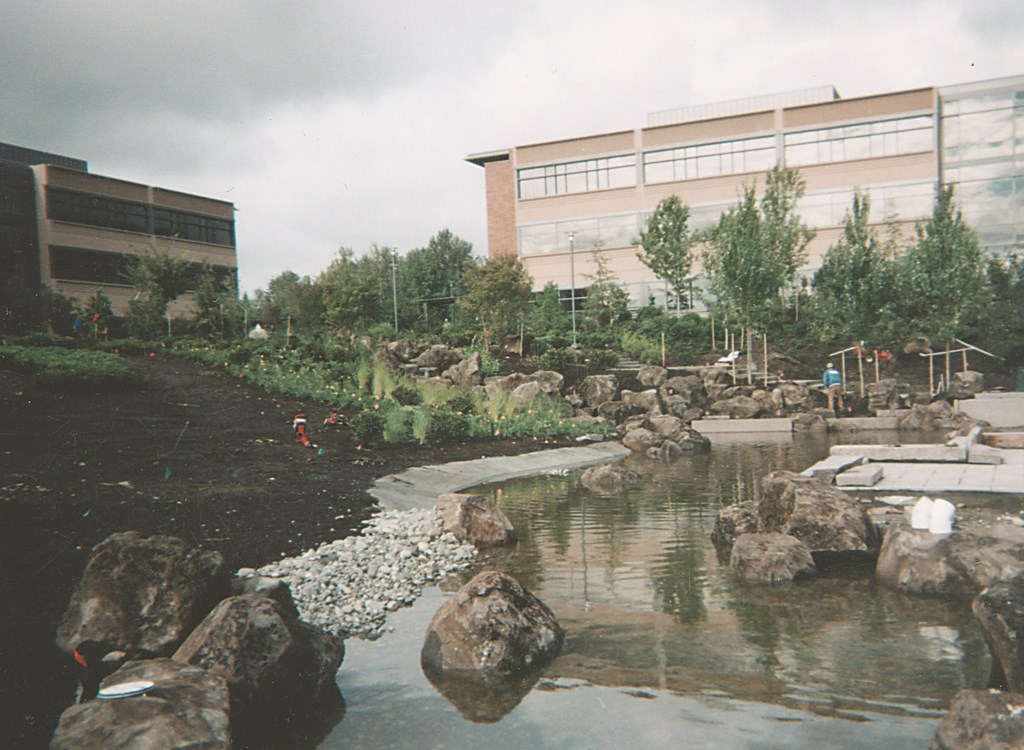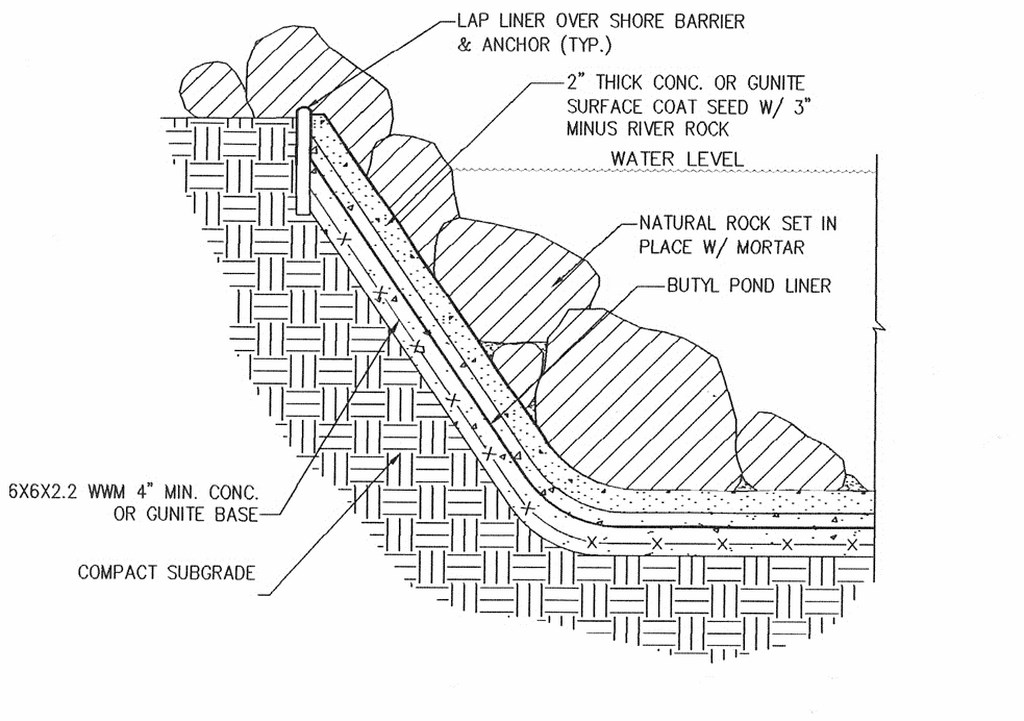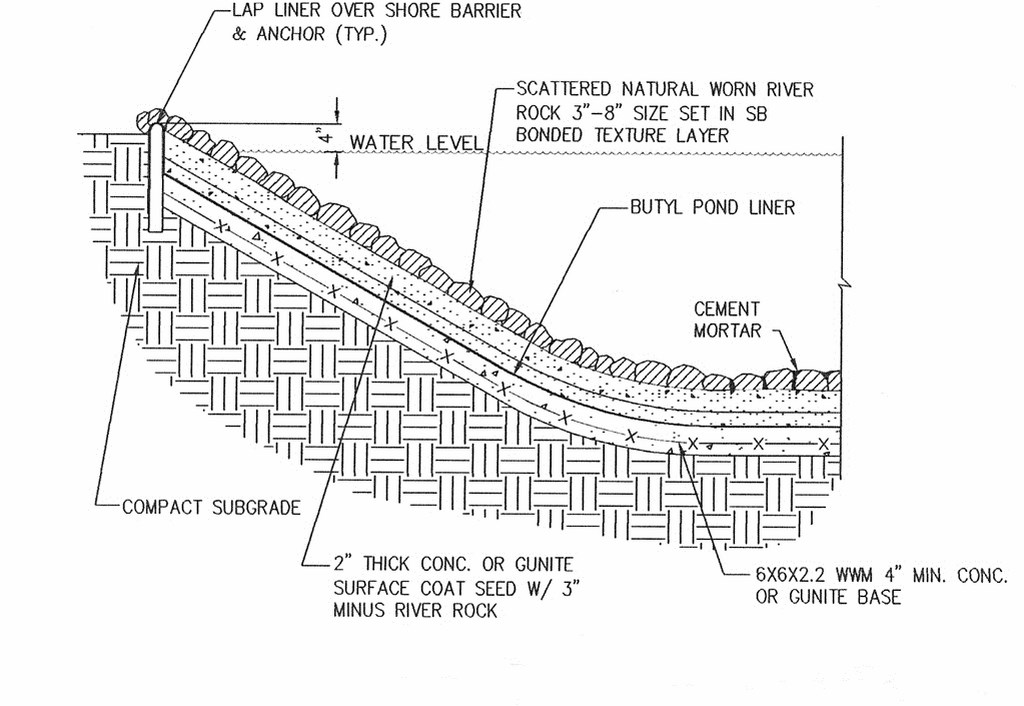A Window into Nature
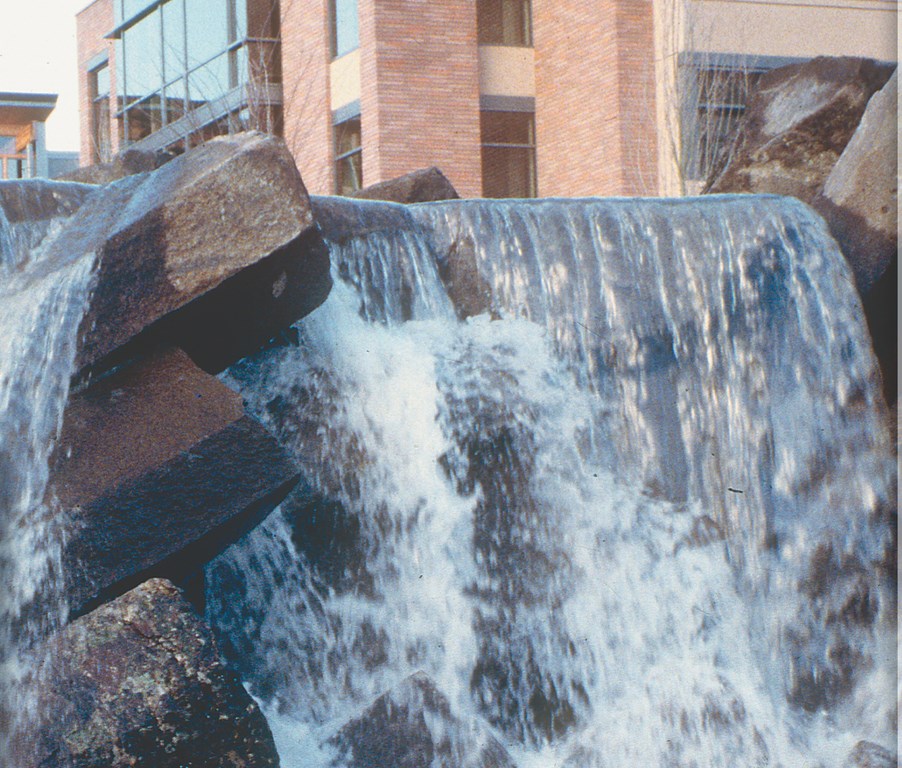
Take the world’s most prolific consumer technology company on one hand and, on the other, its desire to augment its corporate headquarters with a natural exterior environment intended to capture geological processes that span millions of years: It’s a collision of present and past, of technology and nature, that is filled with meaning as well as exciting potential.
Those sorts of thoughts and paradoxes were somewhere on everyone’s minds as we approached the design and installation of a grand-scale watershape at Microsoft’s Redmond, Wash., corporate campus. Our aim: to create a spectacular and entirely naturalistic stream that would serve as a focal point at the entrance to the facility while providing multiple downstream spaces for relaxation and reflection for the firm’s employees and visitors.
Designed by Seattle landscape architect and stone artist Robert Murase, the amalgamation of streams, ponds and waterfalls gets the job done while intricately balancing architectural and natural elements. We at Roman Fountains (Albuquerque, N.M.) were engaged to design and furnish a recirculation system that would realize his ambitious design.
SETTING THE SCENE
The plan was to create a natural stream that would originate with a prominent headwater display near the facility’s main entrance before dropping some 50 vertical feet on a 500-foot-long course marked by rockwork and plantings.
Along the way, the stream was to move through a variety of settings and “interact” with several terraces and pathways before terminating in a broad pond below. As the photographs shown here demonstrate, the outcome is a spectacular man-made stream system – and the most interesting watershape of its kind we’ve ever helped to create.
| The Mother Stone would appear to be the source of all the water that flows through the system, but that’s far from the case: Just 50 gpm flow up and through the stone in a system that has a total flow of 4,500 gpm. |
As is the case with so many projects on this scale, this was truly a collaborative effort. The project team consisted of Robert Murase and our firm as well as a group of major Seattle-based players, including the general contractor, Sellen Construction; the architects, Zimmer-Gunsul-Frasca Partnership; and the engineering consultant, McKinstry Engineering.
Our collective mission was to create an environment that appeared as though it had been there forever – and that the surrounding facility had been built to accommodate nature rather than the other way around. When we first became involved in the project in 1995, the basic design and concept had been set, but several technical and aesthetic details were still being developed.
| The watershape traverses more than 500 feet and drops about 50 feet along the way – a big canvas that gave us latitude to give it several distinctive personalities and set up spaces for different moods and energy levels. |
Over the stream’s 500-foot length and 12,000 square feet of surface area, the design called for changes in width, vertical transitions, speed and the basic “behavior” of the water, which was to start as reflective, quiet pools and meandering, quiet streams before transitioning to vigorous, almost violent cascades in some places. It also called for side streams, backwater eddies, a pair of bridges and a host of spots where staff and guests could get up close and approach the water’s edge.
Our specific role at Roman Fountains was to supply water in the proper volume and flow at various points throughout the elaborate watershape to maximize the desired effects. In that sense, our objective was to make the “mechanics” invisible, allowing observers to forget that they were witnessing a carefully controlled environment. In so doing, we specified flows and volumes, pipe sizes, pumps and filters, suction and return fittings and low-voltage controls.
Although the stream is distinctly naturalistic in appearance, Murase included a great many stones and hardscape structures that appear quarried and architectural, giving spots along the stream a sculptural quality that suggests that people have been at work around the banks of a pre-existing stream. Watching him at work in selecting and placing stones, it became clear that his stream was very much an artistic (and artful) composition.
TOP TO BOTTOM
The stream begins and ends dramatically.
The headwaters emerge from what became affectionately known as the “Mother Stone,” a massive granite boulder that sits at the top of the stream adjacent to the entrance of the main lobby. The boulder measures roughly 15 feet across and has a rough-hewn, angular appearance that might be described as geometric. Quarried in Minnesota and delivered by truck, it now has a four-inch hole core-drilled into it that allows a “spring” of water to gurgle and cascade from the top and down its sides into a 30-foot-diameter source basin.
| The design was intended to convey the impression of a natural waterway that had been there for ages – but that clearly showed the signs of man’s having lived alongside its banks and exercised some control over where and how it flowed. |
The stream ends 50 feet below in a catch basin that has enough capacity to accept most of the system’s 92,000 gallons of water when it’s turned off at night. This area of the stream features tons and tons of layered, columnar basalt pylons mined in eastern Washington. These dramatic stones were formed by the geology of the Cascade Mountains, but they appear to have been cut by hand. In this setting, they create a fantastic-looking 15-foot fall that spills into the lower pond area.
Between these two points, the stream assumes a variety of personalities. Near the top, the stream meanders and has a very restful temperament, slow-moving and shallow as it leaves the Mother Stone’s basin. There are a few changes in elevation, and those are handled with gentle cascades as the stream winds past a terrace where employees can have lunch or escape their offices to create, reflect or have private meetings.
The middle portion of the stream includes a large pond area that feeds more-vigorous transitions that gain water volume and speed over a series of dramatic waterfalls. The drama increases as the stream flows toward the basalt pylons and lower areas that are not readily visible from the top. The cascade offers an element of surprise for those who venture down a series of pathways leading from the Mother Stone into the wilder portions of the composition.
| In it’s ‘wilder’ portions, the stream is indeed entirely natural in appearance – perhaps the best expression of the goal of making it seem as though the buildings and bridges were later additions to a superlative natural landscape. |
Murase has more than 30 years’ experience at building large streams for clients throughout the United States and in Japan and the Caribbean. His attention to detail and precise placement of rock, earth and plantings along this particular stream were instrumental in creating the illusion that the buildings, terraces, lawns, plazas, paths, bridges and trees had been placed around an existing waterway.
He is a truly a master of positioning landscape forms where the obvious works of man intersect and blend convincingly with his illusions of nature. Of particular importance here was the attention he paid to edge treatments, earthen contours and lines of sight from the bridges, paths and terraces. It’s a tremendously restful environment – and one greatly appreciated by Microsoft’s staff.
FEEDING THE STREAM
As mentioned above, it was our charge at Roman Fountains to stage water effects that made the stream, ponds and falls seem natural while maximizing the drama of the design.
To manage the large volume of water flowing through the system, we divided the hydraulic layout into three separate pumping circuits, one each for the upper, middle and lower portions of the stream. The trick was to draw water from and return it to these specific areas in a balanced way that gave the illusion of a single, continuous flow of water.
| The basalt pylons of the lower falls offer the most dramatic impression of all with a flow of 2,100 galloins per minute. The pylons look as though they’ve been sculpted, but they’re actually natural formations collected in eastern Washington. |
Each subsystem has a series of elevation drops and a distinct upper and lower basin. Bridges that traverse the stream at its narrowest points cover the intersections of these separate areas.
The first subsystem feeds the Mother Stone and the upper basin via a series of submerged returns in the source pool and delivers 1,260 gallons per minute. A 20-horsepower pump drives the circulation through 12-inch suction plumbing and 10-inch return plumbing.
Water is added to the flow at the beginning of the second system beneath the upper bridge. It circulates 1,050 gpm using a 15-hp pump on 12-inch plumbing. Using returns beneath the lower bridge, the bottom section adds another 2,100 gpm for the lower falls. A 30-hp pump powers that loop through 14-inch suction piping and 12-inch return plumbing.
The three systems combine for a total system flow rate of 4,500 gpm. Interestingly, the flow from the Mother Stone, which is the only visible source of water, adds only 50 gpm. The rest of the water is introduced at each level through large, recessed sumps with attached diverter plates that are covered with the natural river rock that lines the stream floors. These sump and plate assemblies act as stilling wells that limit turbulence as water is introduced at the various levels.
Water clarity was of absolute importance to the client, so each of the three systems was rigged with filtration and treatment systems capable of keeping the water crystal clear. The system contains no plant or animal life, so the treatment system is more akin to what you’d find in a fountain or a swimming pool.
Each subsystem has a separate, permanent-media sand filter, each a 33-inch tank with a separate, 3-hp pump that moves 100 gpm – thus giving the entire system a six-hour filtration-turnover rate. The water is treated chemically with ozone and erosion-type chlorine feeders.
The display and filtration systems were assembled at our factory on large skid platforms complete with suction strainers, valves and suction- and discharge-piping headers for quick on-site plumbing connections. Each system was tested, hydraulically and electrically, before shipment. Several control panels also were designed, built and tested at our facility.
On site, electronic water sensors were located strategically along the stream to monitor the water level and add make-up water as needed. For evening viewing, only the Mother Stone and the basalt pylons are lit – in this case with a series of submersible lights burning 500-watt tungsten-halogen lamps.
NET RESULTS
 Our portion of the project spanned eight months. Once we finished, we spent a bit more time on site to start and fine-tune the system before training Microsoft’s facility personal in the operation and maintenance of the system.
Our portion of the project spanned eight months. Once we finished, we spent a bit more time on site to start and fine-tune the system before training Microsoft’s facility personal in the operation and maintenance of the system.
| In setting up the recirculating system, our goal with the water was to achieve complete, crystalline clarity. That meant setting up a sanitizing system more similar to one you’d find on a pool or fountain than on a living, natural stream. |
The finished stream accomplished all of the goals identified at the beginning of the project. If anything, the stunning rockwork and changing water effects are more dramatic and interesting than those of us on the design team (with the possible exception of Robert Murase) could have imagined.
I don’t know if Bill Gates has spent much time enjoying this remarkable work of art or to what degree he appreciates the achievement outside his corporate front door, but from our perspective, it was an honor to be part of such a talented team and to participate in producing work that has been so fully and beautifully realized on such a grand scale.
Jon Mitovich is president and general manager of Roman Fountains, a designer and manufacturer of fountain-system packages and components based in Albuquerque, N.M. He graduated in 1976 from Southern Methodist University’s Cox School of Business in Dallas and has participated in seminars on fountain and pool design at UCLA and Harvard’s Graduate School of Design. Mitovich is a member of the American Society of Landscape Architects, the Construction Specifications Institute and the National Spa & Pool Institute. He has conducted classes and seminars on the fountain business and fountain design for various ASLA and NSPI chapters to help watershapers understand the origin, history and application of water in architectural environments. He also has written for a variety of trade publications, including WaterShapes.
Normal
0
false
false
false
EN-US
X-NONE
X-NONE
MicrosoftInternetExplorer4
Microsoft’s corporate campus near Seattle has been the birthplace of much of the world’s most significant consumer-electronics technology. When it came time to adorn the ultramodern facility with a watershape of it own, the scope and complexity of the system was intended to reflect the scale and grandeur of the world’s most famous software company – and to fit a circumscribed space as though it had been there from time immemorial.
Take the world’s most prolific consumer technology company on one hand and, on the other, its desire to augment its corporate headquarters with a natural exterior environment intended to capture geological processes that span millions of years: It’s a collision of present and past, of technology and nature, that is filled with meaning as well as exciting potential.
Those sorts of thoughts and paradoxes were somewhere on everyone’s minds as we approached the design and installation of a grand-scale watershape at Microsoft’s Redmond, Wash., corporate campus. Our aim: to create a spectacular and entirely naturalistic stream that would serve as a focal point at the entrance to the facility while providing multiple downstream spaces for relaxation and reflection for the firm’s employees and visitors.
Designed by Seattle landscape architect and stone artist Robert Murase, the amalgamation of streams, ponds and waterfalls gets the job done while intricately balancing architectural and natural elements. We at Roman Fountains (Albuquerque, N.M.) were engaged to design and furnish a recirculation system that would realize his ambitious design.
SETTING THE SCENE
The plan was to create a natural stream that would originate with a prominent headwater display near the facility’s main entrance before dropping some 50 vertical feet on a 500-foot-long course marked by rockwork and plantings.
Along the way, the stream was to move through a variety of settings and “interact” with several terraces and pathways before terminating in a broad pond below. As the photographs shown here demonstrate, the outcome is a spectacular man-made stream system – and the most interesting watershape of its kind we’ve ever helped to create.
As is the case with so many projects on this scale, this was truly a collaborative effort. The project team consisted of Robert Murase and our firm as well as a group of major Seattle-based players, including the general contractor, Sellen Construction; the architects, Zimmer-Gunsul-Frasca Partnership; and the engineering consultant, McKinstry Engineering.
Our collective mission was to create an environment that appeared as though it had been there forever – and that the surrounding facility had been built to accommodate nature rather than the other way around. When we first became involved in the project in 1995, the basic design and concept had been set, but several technical and aesthetic details were still being developed.
Over the stream’s 500-foot length and 12,000 square feet of surface area, the design called for changes in width, vertical transitions, speed and the basic “behavior” of the water, which was to start as reflective, quiet pools and meandering, quiet streams before transitioning to vigorous, almost violent cascades in some places. It also called for side streams, backwater eddies, a pair of bridges and a host of spots where staff and guests could get up close and approach the water’s edge.
Our specific role at Roman Fountains was to supply water in the proper volume and flow at various points throughout the elaborate watershape to maximize the desired effects. In that sense, our objective was to make the “mechanics” invisible, allowing observers to forget that they were witnessing a carefully controlled environment. In so doing, we specified flows and volumes, pipe sizes, pumps and filters, suction and return fittings and low-voltage controls.
Although the stream is distinctly naturalistic in appearance, Murase included a great many stones and hardscape structures that appear quarried and architectural, giving spots along the stream a sculptural quality that suggests that people have been at work around the banks of a pre-existing stream. Watching him at work in selecting and placing stones, it became clear that his stream was very much an artistic (and artful) composition.
TOP TO BOTTOM
The stream begins and ends dramatically.
The headwaters emerge from what became affectionately known as the “Mother Stone,” a massive granite boulder that sits at the top of the stream adjacent to the entrance of the main lobby. The boulder measures roughly 15 feet across and has a rough-hewn, angular appearance that might be described as geometric. Quarried in Minnesota and delivered by truck, it now has a four-inch hole core-drilled into it that allows a “spring” of water to gurgle and cascade from the top and down its sides into a 30-foot-diameter source basin.
The stream ends 50 feet below in a catch basin that has enough capacity to accept most of the system’s 92,000 gallons of water when it’s turned off at night. This area of the stream features tons and tons of layered, columnar basalt pylons mined in eastern Washington. These dramatic stones were formed by the geology of the Cascade Mountains, but they appear to have been cut by hand. In this setting, they create a fantastic-looking 15-foot fall that spills into the lower pond area.
Between these two points, the stream assumes a variety of personalities. Near the top, the stream meanders and has a very restful temperament, slow-moving and shallow as it leaves the Mother Stone’s basin. There are a few changes in elevation, and those are handled with gentle cascades as the stream winds past a terrace where employees can have lunch or escape their offices to create, reflect or have private meetings.
The middle portion of the stream includes a large pond area that feeds more-vigorous transitions that gain water volume and speed over a series of dramatic waterfalls. The drama increases as the stream flows toward the basalt pylons and lower areas that are not readily visible from the top. The cascade offers an element of surprise for those who venture down a series of pathways leading from the Mother Stone into the wilder portions of the composition.
Murase has more than 30 years’ experience at building large streams for clients throughout the United States and in Japan and the Caribbean. His attention to detail and precise placement of rock, earth and plantings along this particular stream were instrumental in creating the illusion that the buildings, terraces, lawns, plazas, paths, bridges and trees had been placed around an existing waterway.
He is a truly a master of positioning landscape forms where the obvious works of man intersect and blend convincingly with his illusions of nature. Of particular importance here was the attention he paid to edge treatments, earthen contours and lines of sight from the bridges, paths and terraces. It’s a tremendously restful environment – and one greatly appreciated by Microsoft’s staff.
FEEDING THE STREAM
As mentioned above, it was our charge at Roman Fountains to stage water effects that made the stream, ponds and falls seem natural while maximizing the drama of the design.
To manage the large volume of water flowing through the system, we divided the hydraulic layout into three separate pumping circuits, one each for the upper, middle and lower portions of the stream. The trick was to draw water from and return it to these specific areas in a balanced way that gave the illusion of a single, continuous flow of water.
Each subsystem has a series of elevation drops and a distinct upper and lower basin. Bridges that traverse the stream at its narrowest points cover the intersections of these separate areas.
The first subsystem feeds the Mother Stone and the upper basin via a series of submerged returns in the source pool and delivers 1,260 gallons per minute. A 20-horsepower pump drives the circulation through 12-inch suction plumbing and 10-inch return plumbing.
Water is added to the flow at the beginning of the second system beneath the upper bridge. It circulates 1,050 gpm using a 15-hp pump on 12-inch plumbing. Using returns beneath the lower bridge, the bottom section adds another 2,100 gpm for the lower falls. A 30-hp pump powers that loop through 14-inch suction piping and 12-inch return plumbing.
The three systems combine for a total system flow rate of 4,500 gpm. Interestingly, the flow from the Mother Stone, which is the only visible source of water, adds only 50 gpm. The rest of the water is introduced at each level through large, recessed sumps with attached diverter plates that are covered with the natural river rock that lines the stream floors. These sump and plate assemblies act as stilling wells that limit turbulence as water is introduced at the various levels.
Water clarity was of absolute importance to the client, so each of the three systems was rigged with filtration and treatment systems capable of keeping the water crystal clear. The system contains no plant or animal life, so the treatment system is more akin to what you’d find in a fountain or a swimming pool.
Each subsystem has a separate, permanent-media sand filter, each a 33-inch tank with a separate, 3-hp pump that moves 100 gpm – thus giving the entire system a six-hour filtration-turnover rate. The water is treated chemically with ozone and erosion-type chlorine feeders.
The display and filtration systems were assembled at our factory on large skid platforms complete with suction strainers, valves and suction- and discharge-piping headers for quick on-site plumbing connections. Each system was tested, hydraulically and electrically, before shipment. Several control panels also were designed, built and tested at our facility.
On site, electronic water sensors were located strategically along the stream to monitor the water level and add make-up water as needed. For evening viewing, only the Mother Stone and the basalt pylons are lit – in this case with a series of submersible lights burning 500-watt tungsten-halogen lamps.
NET RESULTS
Our portion of the project spanned eight months. Once we finished, we spent a bit more time on site to start and fine-tune the system before training Microsoft’s facility personal in the operation and maintenance of the system.
The finished stream accomplished all of the goals identified at the beginning of the project. If anything, the stunning rockwork and changing water effects are more dramatic and interesting than those of us on the design team (with the possible exception of Robert Murase) could have imagined.
I don’t know if Bill Gates has spent much time enjoying this remarkable work of art or to what degree he appreciates the achievement outside his corporate front door, but from our perspective, it was an honor to be part of such a talented team and to participate in producing work that has been so fully and beautifully realized on such a grand scale.
PHOTO CLUSTERS & CAPTIONS
Opener
No caption
Image 1
The Mother Stone would appear to be the source of all the water that flows through the system, but that’s far from the case: Just 50 gpm flow up and through the stone in a system that has a total flow of 4,500 gpm.
Image 2
The watershape traverses more than 500 feet and drops about 50 feet along the way – a big canvas that gave us latitude to give it several distinctive personalities and set up spaces for different moods and energy levels.
Cluster A (Images 3 & 4)
The design was intended to convey the impression of a natural waterway that had been there for ages – but that clearly showed the signs of man’s having lived alongside its banks and exercised some control over where and how it flowed.
Cluster B (Images 5, 6 & 7)
In it’s “wilder” portions, the stream is indeed entirely natural in appearance – perhaps the best expression of the goal of making it seem as though the buildings and bridges were later additions to a superlative natural landscape.
Image 8
The basalt pylons of the lower falls offer the most dramatic impression of all with a flow of 2,100 galloins per minute. The pylons look as though they’ve been sculpted, but they’re actually natural formations collected in eastern Washington.
Image 9
In setting up the recirculating system, our goal with the water was to achieve complete, crystalline clarity. That meant setting up a sanitizing system more similar to one you’d find on a pool or fountain than on a living, natural stream.
SIDEBAR (with three line illustrations and a photo)
Under Foot
The entire watercourse was created using concrete-covered vinyl liners covered in turn by small, screened river rocks that are plainly visible through “gin clear” waters the clients had requested.
To that end, more than 2,000 tons of carnelian granite and basalt rock was transported to the site and set in place under the direct supervision of landscape architect/stone artist Robert Murase.
In setting up these areas, he followed the construction details shown here to the letter – but infused the resulting watershape with a spirit and presence and artistry that goes far beyond anything you might see on ink and paper.
— J.M.
Jon Mitovich is president and general manager of Roman Fountains, a designer and manufacturer of fountain-system packages and components based in Albuquerque, N.M. He graduated in 1976 from Southern Methodist University’s Cox School of Business in Dallas and has participated in seminars on fountain and pool design at UCLA and Harvard’s Graduate School of Design. Mitovich is a member of the American Society of Landscape Architects, the Construction Specifications Institute and the National Spa & Pool Institute. He has conducted classes and seminars on the fountain business and fountain design for various ASLA and NSPI chapters to help watershapers understand the origin, history and application of water in architectural environments. He also has written for a variety of trade publications, including WaterShapes.











